CXCR3
-
Official Full Name
chemokine (C-X-C motif) receptor 3 -
Overview
This gene encodes a G protein-coupled receptor with selectivity for three chemokines, termed CXCL9/Mig (monokine induced by interferon-g), CXCL10/IP10 (interferon-g-inducible 10 kDa protein) and CXCL11/I-TAC (interferon-inducible T cell a-chemoattractant). Binding of chemokines to this protein induces cellular responses that are involved in leukocyte traffic, most notably integrin activation, cytoskeletal changes and chemotactic migration. Alternatively spliced transcript variants encoding different isoforms have been found for this gene. One of the isoforms (CXCR3-B) shows high affinity binding to chemokine, CXCL4/PF4 (PMID:12782716). [provided by RefSeq, Jun 2011] -
Synonyms
CXCR3;chemokine (C-X-C motif) receptor 3;GPR9;MigR;CD182;CD183;Mig-R;CKR-L2;CMKAR3;IP10-R;C-X-C chemokine receptor type 3;CXC-R3;CXCR-3;Mig receptor;IP10 receptor;IP-10 receptor;G protein-coupled receptor 9;chemokine (C-X-C) receptor 3;interferon-inducible protein 10 receptor
Recombinant Proteins
- Human
- Rhesus macaque
- Rat
- Mouse
- Dog
- Bovine
- Goat
- E.coli
- Mammalian Cells
- Wheat Germ
- HEK293
- In Vitro Cell Free System
- His
- GST
- Non
- Flag
- Avi
- Fc
- KSI
Background
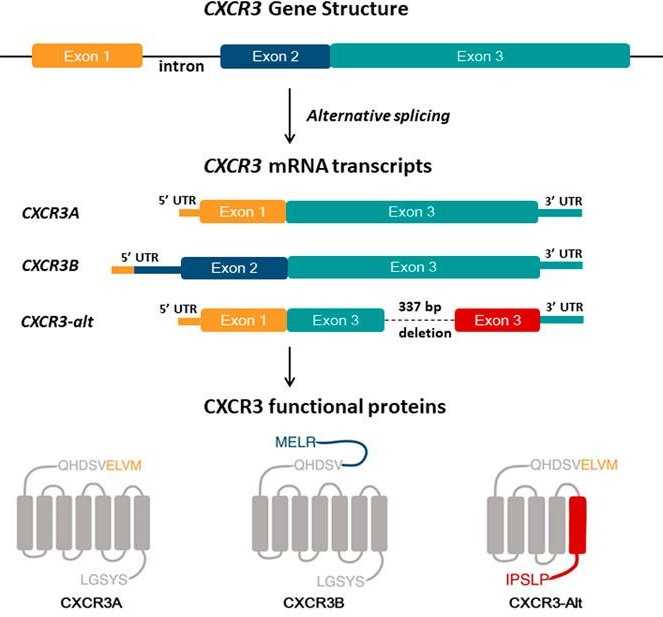
Fig1. Overview of the human CXCR3 gene and CXCR3 isoforms structure. (Devi Satarkar, 2022)
What is CXCR3 Protein?
CXCR3 gene (C-X-C motif chemokine receptor 3) is a protein coding gene which situated on the long arm of chromosome X at locus Xq13. This gene codes for a G protein-coupled receptor that specifically binds to three chemokines: CXCL9 (known as Mig), CXCL10 (or IP10), and CXCL11 (also called I-TAC). When these chemokines latch onto the receptor, they trigger responses in cells that help manage the movement of white blood cells. This includes kicking off processes like integrin activation, changes in the cell structure, and guiding cells to migrate. The CXCR3 protein is consisted of 368 amino acids and CXCR3 molecular weight is approximately 40.7 kDa.
What is the Function of CXCR3 Protein?
The CXCR3 protein is like a key player when it comes to the body's immune response, helping to guide white blood cells to where they're needed most. This G protein-coupled receptor hooks up with specific chemokines, like CXCL9, CXCL10, and CXCL11, which are like signals that call immune cells to action, particularly in inflammation and immune responses. CXCR3 is involved in getting these cells to move, change shape, and activate integrins, which are part of the cell's navigation system. This process is crucial for fighting infections, but can also be relevant in conditions like cancer, autoimmunity, and even viral infections, where the movement of immune cells needs to be tightly regulated.
CXCR3 Related Signaling Pathway
CXCR3 is like the GPS for your immune system. When viruses or bacteria show up, this receptor jumps into action, guiding immune cells to where the trouble is. It does so by catching certain chemical signals, directing immune defenses to infection spots. It's not just about getting cells to move; it also kickstarts some serious cell activity, like getting immune cells fired up, multiplying, and sometimes causing inflammation. So, in simple terms, CXCR3 helps your body's defenses get to the action fast and respond efficiently.
CXCR3 Related Diseases
CXCR3 is like a GPS for immune cells, guiding them to different body areas where help is needed. In diseases like rheumatoid arthritis, it mistakenly leads cells to attack joints, causing pain and swelling. In multiple sclerosis, CXCR3 directs immune cells into the brain, triggering inflammation there. For gut diseases such as Crohn's and ulcerative colitis, it helps immune cells flood into the intestines, keeping the inflammation alive. In heart conditions like atherosclerosis, it guides cells to the artery walls, helping form plaques. And in cancer, CXCR3 can influence how the immune system watches over or even helps the cancer grow. So, CXCR3 is quite the guide, though not always directing traffic in the way we'd like for health.
Bioapplications of CXCR3
CXCR3 is a key player in the immune system and its applications in biology are pretty intriguing. For starters, it helps direct immune cells to the sites of infection or inflammation, kind of like a personal GPS for these cells. In terms of bioapplications, this means CXCR3 can potentially be targeted or utilized in treatments for various diseases, like autoimmune disorders, where the immune response needs fine-tuning. It's like controlling traffic to ensure immune cells reach the right destination without causing too much damage along the way. Plus, its role in cancer treatments is being explored, as it can affect how immune cells recognize and attack tumor cells. So, CXCR3 isn't just a cellular GPS; it might also be a significant tool in designing therapies and managing diseases where the immune response is key.
Case Study
Case Study 1: Haizhan Jiao, 2024
CD4+ helper cells and CD8+ killer cells need to find their way in the body to do their jobs, and that's where chemokines like CXCL9-11 and their receptor, CXCR3, come in. They're like traffic guides, leading these immune cells to their destinations. We've been looking at how CXCR3 teams up with different compounds, like the natural chemokine CXCL11, a peptidomimetic called PS372424, a biaryl compound VUF11222, and an antagonist named SCH546738. Each one binds to the receptor in its own unique way. For example, PS372424 binds in a similar spot to CXCL11, while VUF11222 goes deeper, activating the receptor differently. SCH546738, on the other hand, binds between two helices in the receptor, keeping it in an inactive state. This research not only highlights how these compounds interact with CXCR3 but also hints at new ways to develop drugs targeting this receptor.
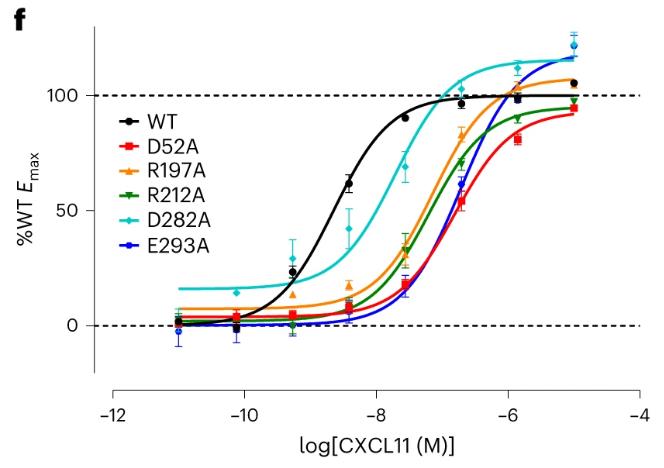
Fig1. cAMP responses are normalized to the percentage agonist activity of wild-type CXCR3.
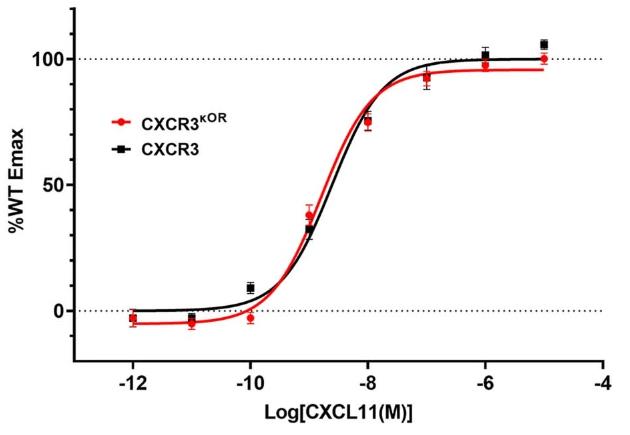
Fig2. cAMP responses of CXCR3 and CXCR3κOR to CXCL11.
Case Study 2: María Ángeles García-López, 2001
Researchers tackled how CXCR3, a kind of chemokine receptor, shows up in different tissues and situations—like in normal and inflamed organs such as in rheumatoid arthritis or Hashimoto's thyroiditis—using specialized antibodies. On certain immune cells like dendritic cells and specific lymphocytes, CXCR3 is quite present. It's also naturally found on the bigger blood vessels but not the smaller ones. When inflammation kicks in, cells with activated CXCR3, especially those in the blood vessels and infiltrating the inflamed area, seem to step up their game. This points to CXCR3 being potentially crucial in directing immune cells to where they're needed during inflammation.
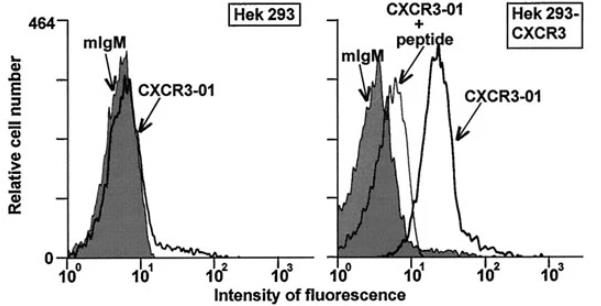
Fig3. Human CXCR3 receptor expression analyzed by flow cytometry in CXCR3- or mock-transfected human embryonic kidney (HEK)-293 cells as indicated.
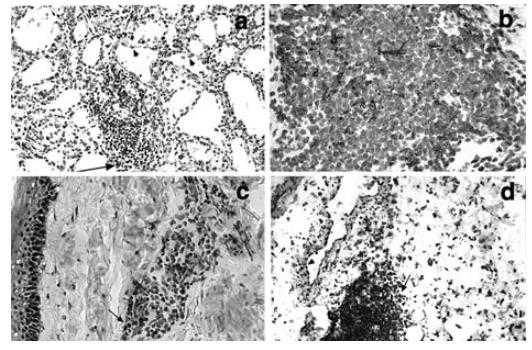
Fig4. CXCR3 expression in patients with Hashimoto's thyroiditis, dermal vasculitis, and rheumatoid arthritis.
Quality Guarantee
High Purity
.jpg)
Fig1. SDS-PAGE (CXCR3-16H)
.
.jpg)
Fig2. SDS-PAGE (CXCR3-2709H)
Involved Pathway
CXCR3 involved in several pathways and played different roles in them. We selected most pathways CXCR3 participated on our site, such as Cytokine-cytokine receptor interaction,Chemokine signaling pathway, which may be useful for your reference. Also, other proteins which involved in the same pathway with CXCR3 were listed below. Creative BioMart supplied nearly all the proteins listed, you can search them on our site.
| Pathway Name | Pathway Related Protein |
|---|---|
| Cytokine-cytokine receptor interaction | CCL6,IFNB1,BMPR1AB,IL6,OSTN,CXCL2,CCR8L,Fasl,CCR9A,RNF207B |
| Chemokine signaling pathway | SHC3,CCR10,GNG11,CXCR2,PLCB3,CXCL12,CCL5,RAP1B,GNGT2,CCR1L1 |
Protein Function
CXCR3 has several biochemical functions, for example, C-X-C chemokine binding,C-X-C chemokine receptor activity,chemokine binding. Some of the functions are cooperated with other proteins, some of the functions could acted by CXCR3 itself. We selected most functions CXCR3 had, and list some proteins which have the same functions with CXCR3. You can find most of the proteins on our site.
| Function | Related Protein |
|---|---|
| C-X-C chemokine binding | CXCR6,CXCR7,HMGB1 |
| C-X-C chemokine receptor activity | CCBP2,CXCR3.1,CXCR5,CXCR4A,CXCR4B,CXCR4,CXCR2,CXCR6,CCR9A,CXCR7 |
| chemokine receptor activity | CCR5,CX3CR1,CXCR3.1,CCR8,CCR3,CCBP2,CXCR7B,ACKR3B,CXCR4B,CXCR3.2 |
| chemokine binding | PLP2,ACKR3B,ACKR4 |
| receptor activity | SV2A,FKBP3,ANTXRL,VMN1R52,KLRG1,OR3A2,RAMP1,GFRA1A,ICAM1,ANPEP |
Interacting Protein
CXCR3 has direct interactions with proteins and molecules. Those interactions were detected by several methods such as yeast two hybrid, co-IP, pull-down and so on. We selected proteins and molecules interacted with CXCR3 here. Most of them are supplied by our site. Hope this information will be useful for your research of CXCR3.
Resources
Gene Families
Research Area
Related Services
Related Products
References
- Tan, JF; Jin, XF; et al. Beneficial effect of T follicular helper cells on antibody class switching of B cells in prostate cancer. ONCOLOGY REPORTS 33:1512-1518(2015).
- Wang, J; Vodovotz, Y; et al. Injury-induced MRP8/MRP14 stimulates IP-10/CXCL10 in monocytes/macrophages. FASEB JOURNAL 29:250-262(2015).



